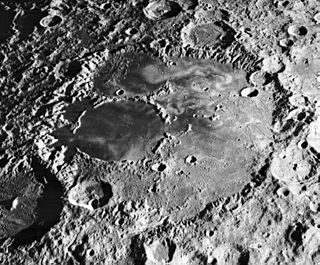
Doppelmayer is the remains of a lunar impact crater that lies on the southwest edge of Mare Humorum. It was named after the German mathematician and astronomer Johann Gabriel Doppelmayr. To the south-southeast is another flooded crater designated Lee, and to the southeast is Vitello. Just to the east-northeast of Doppelmayer lies the nearly submerged crater Puiseux.
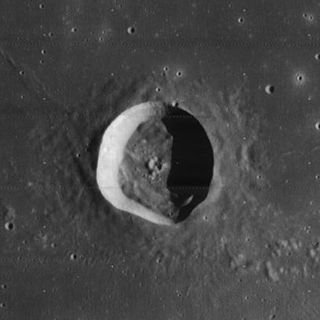
Flamsteed is a small lunar impact crater located on the Oceanus Procellarum, which is named after British astronomer John Flamsteed. It lies almost due east of the dark-hued Grimaldi, and north-northwest of the flooded Letronne bay on the south edge of the mare.

Appleton is a heavily eroded lunar impact crater that lies in the northern hemisphere on the far side of the Moon. To the northwest are the craters Von Neumann and Campbel. The smaller Golovin lies to the northeast, while further to the southwest is the Mare Moscoviense.

Boss is a lunar impact crater that is located along the northeast rim of the Moon's near side. Due to its location, the crater is viewed from the side by observers on the Earth, and its visibility is subject to libration effects.

Baily is the remnant of a lunar impact crater on the boundary between Mare Frigoris to the north and Lacus Mortis to the south. The crater interior has been flooded by lava in the past, and only the northern half of the crater rim remains relatively intact. There is an outward bulge in the northeastern rim, possibly the remnant of another crater formation that once overlapped Baily. The crater interior is flat and relatively featureless, with no impacts of significance. The surviving outer rim reaches a maximum elevation of about 0.5 km.

Calippus is a small lunar impact crater that is located on the eastern edge of the rugged Montes Caucasus mountain range in the northern part of the Moon. It was named after Greek astronomer Callippus of Cyzicus. It lies to the southwest of the crater remnant Alexander, to the northwest of the Mare Serenitatis.
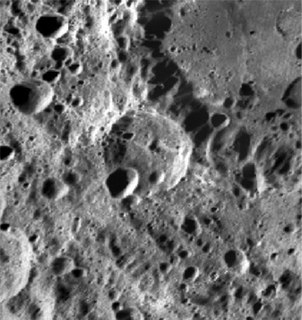
Belyaev is a lunar impact crater that is attached to the outer edge of the Mare Moscoviense, on the far side of the Moon. It is a worn formation with a small crater pair overlaying the southern rim, and several smaller craters across the relatively irregular interior.

Blackett is a lunar impact crater that lies on the far side of the Moon, behind the southwest limb. It lies beyond the southeast outer ring of the immense Mare Orientale basin. The formation of that major feature has left Blackett deeply marked with ridge features trending from the northwest. Much of the crater has been shaped by the ejecta from Mare Orientale, particularly along the western half of the crater.

Cannon is a lunar impact crater that is located near the east-northeastern limb of the Moon's near side. It lies just to the northwest of the Mare Marginis, and south-southeast of the crater Plutarch. Farther to the east-northeast is Hubble.
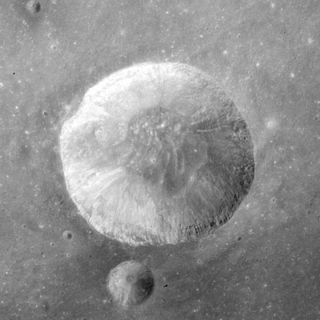
Carmichael is a lunar impact crater that is located along the eastern edge of the Sinus Amoris, in the northeastern quadrant of the Moon's near side. Its diameter is 20 km. It was named after American psychologist Leonard Carmichael. It lies within a couple of crater diameters south-southwest of the smaller crater Hill. Further to the east-northeast is the prominent crater Macrobius. Carmichael was designated Macrobius A before being given its current name by the IAU.

Cook is a lunar impact crater that lies in the western part of the Mare Fecunditatis, just to the southeast of the prominent crater Colombo. To the southwest is Monge.

Crozier is a lunar impact crater that is located on the southwest edge of Mare Fecunditatis, a lunar mare in the eastern part of the Moon's near side. It lies to the east-northeast of the prominent crater Colombo, and southeast of the small crater Bellot.

Debes is a lunar impact crater that is located to the north of the Mare Crisium, in the eastern part of the Moon's near side. It was named after German cartographer Ernst Debes. It lies just to the northwest of the crater Tralles and the prominent Cleomedes.

Eimmart is a lunar impact crater that is located near the east-northeastern limb of the Moon, to the northeast of the Mare Crisium. The northern and eastern outer rim of this crater borders on the narrow Mare Anguis. To the northwest of Eimmart are the smaller crater Delmotte and the prominent Cleomedes.

Fourier is a lunar impact crater that is located in the southwestern part of the Moon's near side, just to the southeast of the crater Vieta. To the northeast is the Mare Humorum. The rim of this crater is roughly circular, but appears oval when viewed from the Earth due to foreshortening.

Gum is a lunar impact crater that is located near the southeastern limb of the Moon, and is viewed nearly from the side from Earth. It lies along the western edge of the irregular Mare Australe, to the northeast of the crater Hamilton. To the north-northwest is the larger Abel, and to the east-southeast on the far side of the Moon is Jenner.

Donner is a lunar impact crater on the far side of the Moon. It is located just to the northeast of the Mare Australe, behind the southeastern limb of the Moon. During favorable librations this part of the lunar surface can be brought into view of the Earth, but the site is viewed from the edge and so not much detail can be seen.

Fridman is the remains of a lunar impact crater on the far side of the Moon. It lies due south of the huge walled plain Hertzsprung, and is attached to the northeastern rim of the crater Ioffe.

Jules Verne is a large lunar impact crater on the far side of the Moon, named after the French author. It is located to the west-southwest of the Mare Ingenii, one of the few lunar mares on the far side. To the southeast of Jules Verne is the crater Lundmark, while Koch is located to the south-southeast. To the northwest is the large walled plain Pavlov.
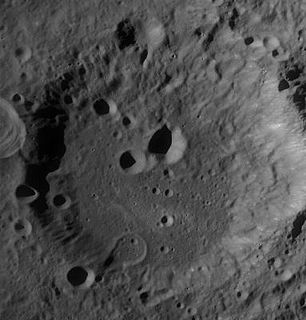
Koch is a crater on the far side of the Moon. It lies in the southern hemisphere, to the south-southeast of the walled plain Jules Verne. Attached to the northeastern rim of Koch by a neck of uneven terrain is the crater Lundmark. Less than one crater diameter to the south of Koch is Crocco.



